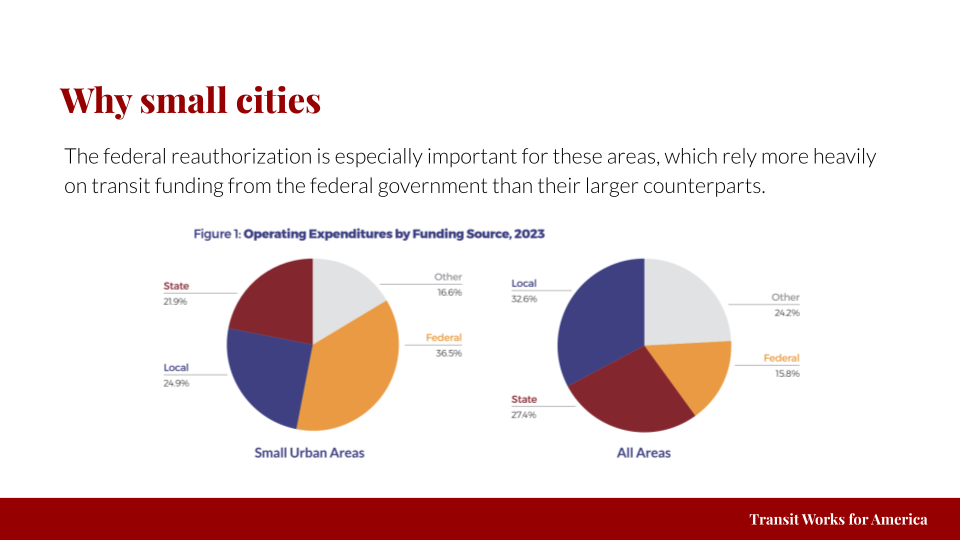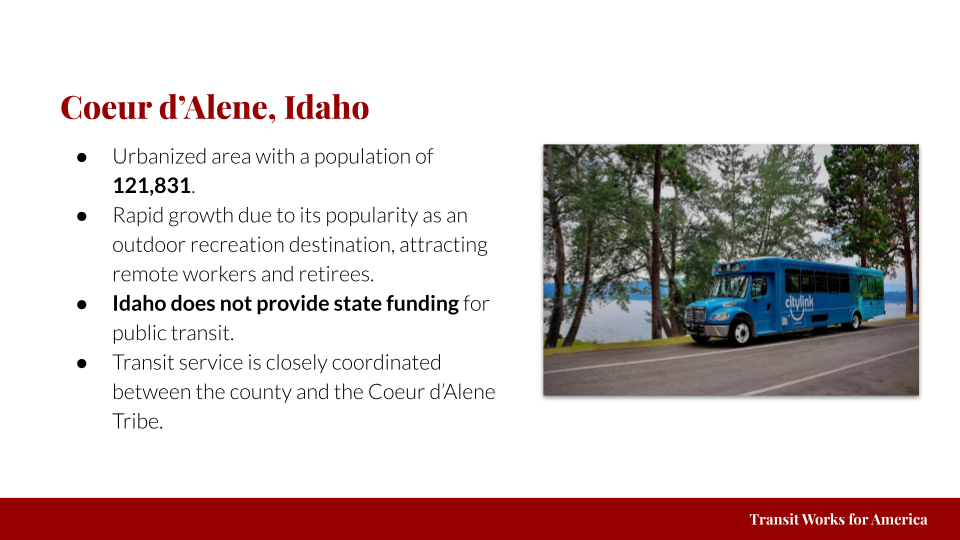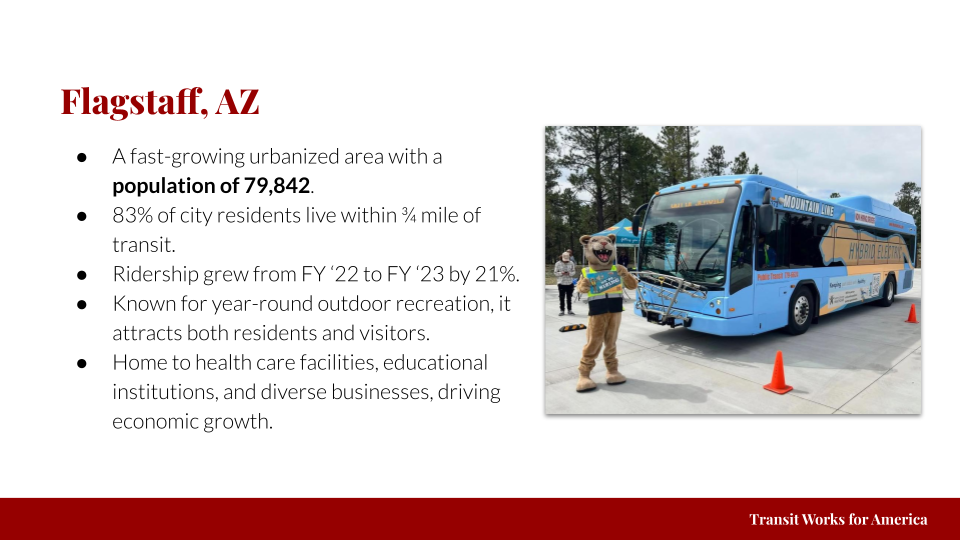We often think of public transit as reserved for big cities. But for small cities, public transit matters for quality of life, health, economic goals, and more.
During a recent webinar, America Walks Executive Director Mike McGinn, Molly McKinley, Chad Ingle of Kootenai County Public Transportation, and Heather Dalmolin of Mountain Line Transit Authority discussed the value of transit in small cities.
The webinar focused on findings from Small Cities, Big Moves: Challenges of Public Transportation in Small Urban Areas, a report facilitated by Just Strategy. Just Strategy builds powerful issue campaigns to educate organizers and movement leaders. Current campaigns include the National Campaign for Transit Justice, Transit Works for America, and Communities for Our Colleges.
Why Transit?
America Walks Executive Director Mike McGinn began the webinar by explaining the connection between transit and walking. Transit is often the middle leg of a walking trip, and it’s the combination of transit, walking, and land use that helps build places where communities can access their daily needs.
The webinar was supported by a number of sponsors, including Active People, Healthy Nation, a campaign of the Centers for Disease Control aimed at increasing physical activity and improving health and quality of life.
Why Small Cities?
In 2023 alone, seven billion trips were taken on public transit in small cities, towns, and rural areas in the U.S., said Molly McKinley, who co-authored the Small Cities, Big Moves report. Demand for transit continues to increase as the cost of car ownership rises. Moreover, fewer young people are interested in driving, and aging populations need more ways to get around. Transit provides an affordable option that allows everyone — including older adults, people with disabilities, young people, and those without cars — to continue participating in the economic and social life of their communities.
There are more than 300 small cities across the country in 49 states, Puerto Rico, Guam, and the Virgin Islands. These cities are hubs for surrounding rural communities, connecting residents to jobs, healthcare, shopping, and other services that may not be available in small towns. Small urban transit covers wide geographies and caters to diverse needs, including local industries, recreational areas, and college or university populations that drive population growth.
To meet demand, small city transit leaders are finding innovative ways to provide service. But they are forced to make difficult trade-offs, including shifting and cutting services in response to insufficient resources. Currently, Congress is considering federal reauthorization for these essential transit services. Small city transit relies more heavily on federal funding than their larger urban peers. Small urban areas receive nearly 37% of their operating expenditure budgets from federal grants, as compared to 16% for transit in all areas. The need for federal funding for capital expenditures is even greater for small city transit. Small urban areas receive just over 60%, versus just over 37% for all areas.

The report highlights seven case studies for small urban transit. It also explores the role transit plays in small city economies and quality of life, as well as challenges and opportunities. Coeur d’Alene, Idaho, and Flagstaff, Arizona, are among the case studies.
Case Study: Coeur d’Alene, Idaho

Coeur d’Alene is one of Idaho’s fastest growing urban areas, with a population exceeding 121,000. The city is known for its outdoor lifestyle, which recently has attracted remote workers and retirees.
Idaho, however, does not provide state funding for transit. So Kootenai County-operated transit provider CityLink must rely on in-kind contributions, annual cash support from local jurisdictions, and creative partnerships to meet federal matching requirements.
Chad Ingle, Program Manager for Kootenai County Public Transportation, spoke on the value of these partnerships, including coordination with the Coeur d’Alene Tribe, to connect county residents to the local economy and services. CityLink runs fixed routes, paratransit, and non-emergency medical transportation in collaboration with the local hospital. There is also an on-demand service that extends coverage to older people and those with disabilities outside of the main service area.
Limited local revenue options and significant federal matching requirements inhibit the county’s capacity to expand services. These constraints directly impact the community. For example, Project SEARCH, a high school transition program that provides education and training to young adults with intellectual and developmental disabilities, relies on public transit to help its participants access meaningful employment, independence, and quality of life.
Case Study: Flagstaff, Arizona

Flagstaff, Arizona, is a fast-growing urbanized area with a population of nearly 80,000. Known for year-round outdoor recreation that attracts both residents and visitors, the small city is a hub for healthcare, education, and business.
Heather Dalmolin, CEO and General Manager of Mountain Line Transit Authority, shared that they work hard to find the right solutions for the community, such as helping university students get to and from housing, creating a pass program for employers to provide workers with free bus passes, and focusing on improving bicycle and pedestrian ways.
When the school district was forced to eliminate yellow bus service for out-of-district middle school students and all high school students within city limits, Mountain Line partnered with the district to supply students with bus passes to encourage ridership. Today, more than 1,000 students (representing 60% of those eligible) ride public transit to school.
The Value of Public Transit in Small Cities
The panelists answered questions from the audience about funding, advocating for public transit, the role of transit in economic development, and more.
On advocating for transit in local communities, Chad advised that making your voice heard is key. Public transit agencies must seek the input of the public, so they want to hear from their riders. “Public transportation is another community asset, and it needs to be seen as that.”
When it comes to making sure residents’ needs are met, Chad said that “any time we can speak to those populations that really depend on public transportation, it works wonders. Whenever we can speak to the heart of people and then show it through data points, it really resonates.”
Advocating for the importance of public transportation means shifting the false perception that transit only services a small part of the community. “Transit is not just about serving people who don’t own cars,” said Heather. “It is so much bigger than that.”
Heather also spoke to the importance of policies that support transit. Many rural communities not built on a grid are not conducive to high-frequency transit, but they should have policies regarding land use and new development that prioritize public transportation that serves the community.
As for communicating the value of transit, Heather believes “there’s a way to talk about transit to everyone on the face of the earth.” To find the right messaging, think about how transit helps your audience.
Molly mentioned that the transit agencies in the report were instrumental in connecting the writers to riders to share their experiences. She recounted speaking with a rider with a visual impairment who uses on-demand services every day to go to work and the gym. These stories demonstrate the value of transit and break down assumptions about who it is for. “Transit makes our community better.”




